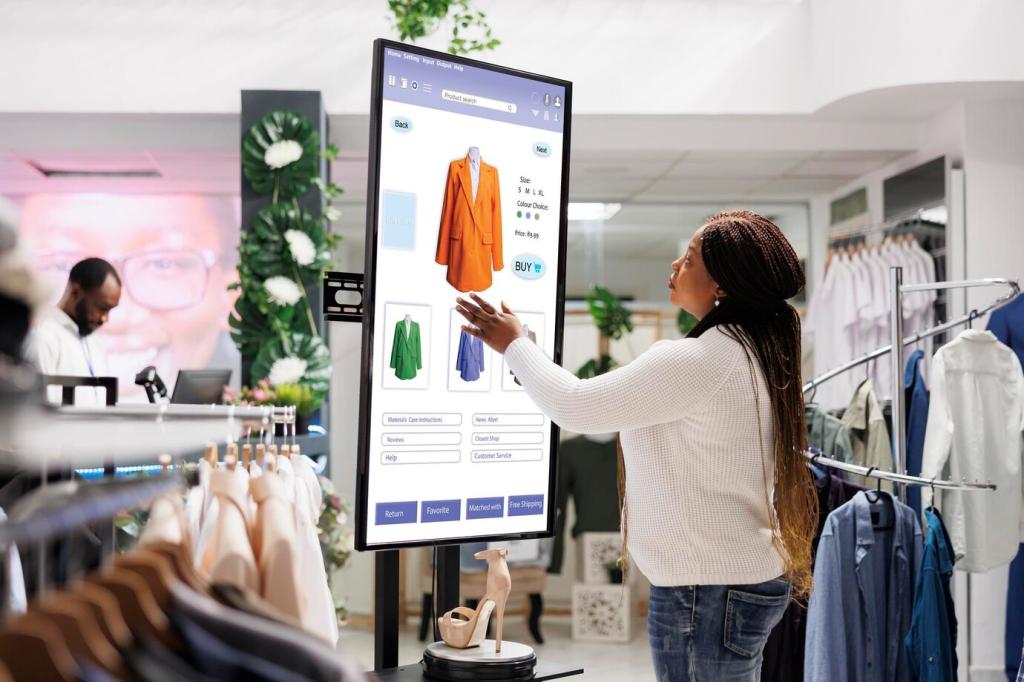
The Future of AI in Online Retail: Trends and Predictions
Chosen theme: The Future of AI in Online Retail: Trends and Predictions. Step into a shopper-first future where intelligent storefronts anticipate intent, operations hum invisibly, and every interaction feels tailored. Join us, share your voice, and shape what comes next.
From Static Catalogs to Living Stores
Yesterday’s storefront listed products; tomorrow’s will converse, predict, and curate. AI transforms browsing into guidance, blending behavioral signals, context, and creative generation so each visit feels like a helpful shop assistant who remembers tastes, budget, and changing needs without ever feeling pushy.
Anecdote: A Boutique’s Overnight Pivot
When a small apparel boutique added AI recommendations during a rainy weekend, shoppers saw right-size fits and weather-aware pairings. Average order value rose, returns dipped, and the founder emailed customers by name with styles that matched their mood. One tweak, lasting loyalty.
Join the Conversation
What moment made AI feel real in your store or shopping life? Tell us below, ask a question, or challenge a prediction. Your stories and skepticism sharpen our insights—subscribe to keep the dialogue going as new experiments land.
Trends and Predictions for the Next 3 Years

Generative Search and Discovery
Typing gives way to talking and showing. Expect multimodal search where shoppers upload a photo, describe a vibe, or set constraints—and generative AI assembles options with transparent rationale. Merchandising becomes orchestration, guiding discovery with context, ethics, and clear guardrails.

Predictive Supply Chains
Retailers will forecast demand at SKU and neighborhood levels, align inventory with micro-fulfillment, and flex purchase orders to weather swings. The prize is availability without overstock, achieved through probabilistic models that learn from seasonality, social buzz, and real-time events.

Conversational Commerce Everywhere
Shopping flows into chats, voice assistants, and social DMs. Agents will answer fit questions, bundle accessories, and track orders with memory of past choices. Subscribe to follow pilots comparing voice conversions, agent guardrails, and how to keep conversations on-brand and helpful.
Personalization That Respects People
First-Party Data Done Right
Cookieless realities reward retailers who ask clearly, store carefully, and personalize meaningfully. Preference centers, value exchanges, and short, plain-language disclosures build durable relationships. The rule: if personalization doesn’t help the shopper today, don’t collect it—and absolutely explain why.
Fairness, Bias, and Inclusion
Prediction is powerful and imperfect. Use representative training data, run bias audits, and test for disparate impact across groups. Document assumptions and enable appeal paths so customers can correct profiles. Fair models don’t just comply; they broaden access and long-term loyalty.
Trust as a Growth Strategy
Transparent badges like “Why you’re seeing this,” model cards, and clear opt-outs reduce friction and raise conversions. Tell customers how AI helps with fit, price, and timing, not just clicks. Comment with your favorite trust practice—we’ll feature highlights in our next post.


Intelligent Fulfillment and Routing
AI coordinates picking waves, slotting, and courier selection to balance cost and speed. Think dynamic batching that adapts to live order flow and traffic. The outcome is fewer split shipments, happier drivers, and delivery windows that customers can trust on busy days.
Returns Prevention and Recovery
Virtual try-on, size prediction, and material visualization reduce fit-related returns before they happen. Post-purchase, AI flags likely returns and suggests fixes—alterations, exchanges, or reuse channels—cutting landfill and cost. Share your returns pain points; we’ll tailor a deep dive series.
Sustainability Through Optimization
Smarter packing, consolidated routes, and greener delivery slots lower emissions without sacrificing delight. Models weigh weather, density, and carrier performance to propose eco-friendly choices. If sustainability matters to you, subscribe for our upcoming benchmark on carbon savings per order.


Metrics That Matter in AI Retail
Correlations mislead. Use randomized holdouts, geo experiments, or causal uplift modeling to quantify incremental impact. Track not only conversion and AOV, but also return rate, margin, and customer satisfaction. Publish learnings internally so teams refine models, not just celebrate wins.
Metrics That Matter in AI Retail
CLV becomes dynamic, updating with each interaction and macro shift. Tie acquisition spend to predicted payback windows, and protect long-term health by capping aggressive discounts. Watch for model drift; recalibrate regularly so predictions stay useful through seasons and supply changes.
Your Roadmap to the AI-Powered Storefront

Map data sources, consent flows, and pain points across the journey—discovery, checkout, fulfillment, support. Choose one high-impact pilot with clear metrics and a two-month runway. Share your pilot ideas in the comments; we’ll crowdsource feedback and report progress openly.
